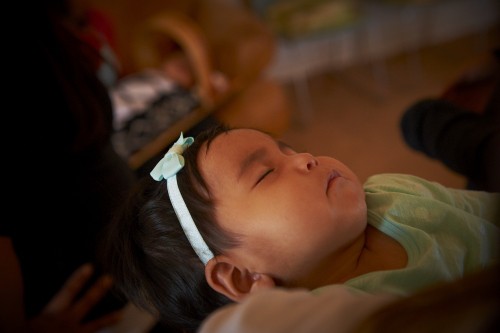
Before the widespread use of rotavirus vaccines, rotavirus was a leading cause of gastroenteritis among US children younger than 5 years of age. Navajo and White Mountain Apache children suffer a disproportionate burden of severe rotavirus disease compared with the general US population. The Center participated in a multi-center, double blind randomized controlled trial of a pentavalent, human-bovine reassortant rotavirus vaccine conducted from 2002-2004. This was part of a large international study in which around 70,000 children in 11 countries were enrolled. Eligible infants were randomized to receive either the rotavirus vaccine (manufactured by Merck Research Laboratories) or placebo. The ratio of enrollees in the two groups was 1:1.
A total of 1,008 Navajo and White Mountain Apache children participated in the study. Healthy infants aged 6-12 weeks were visited at home 6-8, 13-15, and 42-43 days after receipt of the vaccine or placebo. To monitor the safety of the vaccine, parents were asked if the infant had any adverse reactions after dosing such as diarrhea, vomiting, fever, rash, blood in stools, abdominal pain or any other symptoms compatible with intussusception. If a parent reported a case of gastroenteritis, 2 stools were collected at least 24 hours apart within 14 days of the start of the episode. Stool samples were tested for presence of rotavirus by antigen testing. A previously established 24-point scoring system was used to determine severity of the rotavirus illness.
The multi-center trial findings showed that the rotavirus vaccine was 74% efficacious in preventing gastroenteritis caused by G1-G4 rotavirus serotypes. Efficacy against severe disease was 98%. Findings from only the Navajo and White Mountain Apache cohort were that the vaccine was 77% efficacious in preventing gastroenteritis caused by rotavirus. This vaccine, which is now part of the routine childhood immunization schedule, has dramatically reduced serious diarrheal disease in Native American children, as well as in children around the world.
Resources
Selected Publications
- Efficacy of a pentavalent human-bovine reassortant rotavirus vaccine against rotavirus gastroenterit
- Detection of G3P[3] and G3P[9] rotavirus strains in American Indian children
- Lack of nonspecific protection against all-cause nonrotavirus gastroenteritis by vaccination
- Epidemiologic and clinical features of other enteric viruses associated with acute gastroenteritis